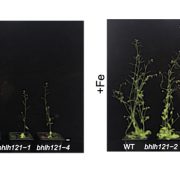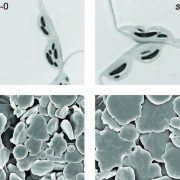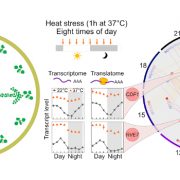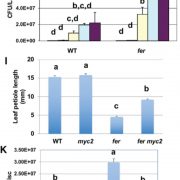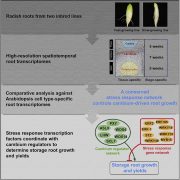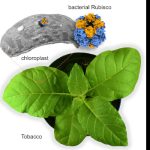Runaway transcription makes plants sensitive to heat stress

Kim et al. investigate the role of a heat shock protein in thermotolerance.
https://doi.org/10.1093/plcell/koac351
By Minsoo Kim and Elizabeth Vierling at UMass Amherst
Background: Plants can survive heat stress by producing heat shock proteins (HSPs) that protect and rescue other proteins. One HSP, the ATP-dependent protein disaggregase HSP101, is essential for tolerance to severe heat. However, a semi-dominant mutation in HSP101 makes the protein toxic, so mutant plants cannot survive even a mild heat stress that does not require HSP101.
Questions: How does HSP101 work at the molecular level and what other players are important for heat stress tolerance? We isolated Arabidopsis mutant plants that suppress toxicity of this HSP101 mutant.
Findings: One suppressor mutant has a point mutation in CstF77, which functions in termination of gene transcription. Interestingly, the cstf77 mutant protein loses activity only at high temperatures when many HSPs, including HSP101, are produced. Thus, the cstf77 mutant cannot properly terminate transcription of the toxic HSP101. This results in lower accumulation of the toxic HSP101, which rescues sensitivity of the mutant plants to mild heat stress. However, the cstf77 mutation makes plants more sensitive to extreme heat stress because CstF77 is required for proper termination and expression of many genes important for heat stress tolerance.
Next steps: The activity of CstF77 appears limited to a small group of heat-induced genes during heat stress, and the mechanism responsible for this effect requires investigation. It is also important to identify other genes responsible for overcoming the toxic HSP101. Understanding molecular mechanisms of heat stress tolerance will allow us to engineer plants that are more resistant to heat stress.
Minsoo Kim, John Swenson, Fionn McLoughlin, and Elizabeth Vierling. (2023). Mutation of the polyadenylation complex subunit CstF77 reveals that mRNA 3’ end formation and HSP101 levels are critical for a robust heat stress response. https://doi.org/10.1093/plcell/koac351



